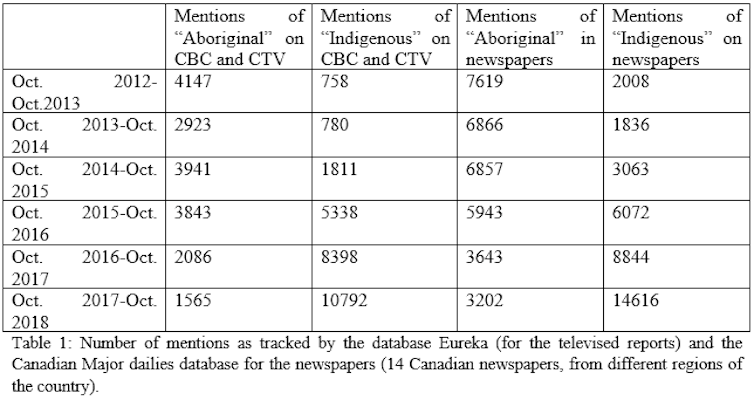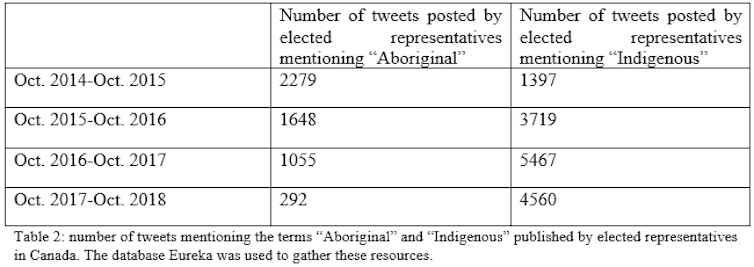Justice and reconciliation with Indigenous Peoples have been key priorities since Justin Trudeau was elected in October 2015.
Prime Minister Trudeau and key cabinet ministers have often expressed their desire to strike a renewed relationship with Indigenous Peoples, one in which the Indigenous will have a meaningful role to play in formulating and implementing policies that impact their communities.
What’s in a designation?
Many terms have been used by the Canadian media to refer to the original inhabitants of Canada: Indian, First Nations, Native, Aboriginal and Indigenous. But the term used in public discourse is important because it’s tied to identity and it matters whether this identity is provided by outside officials or by the group itself.
The term “Indian” might be the most obvious example of a name being thrust upon First Nations from those outside their communities. The term “Aboriginal” was also considered to be an external creation, and prompted the Association of Manitoba Chiefs and the Anishinabeks of Ontario to reject it in 2014.
However, “Aboriginal” carries legal ramifications as it is used in the 1982 Canadian Constitution in both Section 35 and the Charter of Rights and Freedoms, for example.
Recently, the term “Indigenous” has gained credence as a more appropriate terminology as it refers to rights laid out in the United Nations Declaration of the Rights of Indigenous Peoples. Both terms, Aboriginal and Indigenous, are tied to legal documents with important consequences in terms of consultation and rights, although Indigenous carries a more global undertone.
What about the terms preferred by the Canadian media?
From Aboriginal to Indigenous
Such question can only be answered by looking over long periods of time at different media outlets. My research suggests there is strong evidence that the Canadian media started to change their practice after the election of the Trudeau government.
As seen in the table below, the term “Aboriginal” was the dominant one used in televised reports and newspaper articles before October 2015; the situation evolved dramatically after October 2015. We can also conclude from the data below that Indigenous issues have gained more attention and reached an extended audience after the 2015 election.
Author provided
There are different ways to explain this evolution.
For one, maybe specific initiatives can account for the increased use of the designation “Indigenous.” For example, the mentions of the National Inquiry into Missing and Murdered Indigenous Women, Indigenous and Northern Affairs Canada or the United Nations Declaration of the Rights of Indigenous Peoples could have explained this change of language.
That would suggest the shift is more a consequence of specific institutions or documents than a change in journalistic practices.
But these three initiatives only account for under 10 per cent of the hits after October 2015.
Another explanation could be that left-leaning or more progressive media such as the CBC or the Toronto Star have led this evolution. However, Postmedia newspapers (including the National Post, Ottawa Citizen and Montreal Gazette, among others) also joined this movement in 2016-2017 by using Indigenous more frequently than Aboriginal.
The role of social media
Political leadership can create momentum on issues, in this case for an increased emphasis on Indigenous justice and reconciliation. In fact, the evolution in media practices followed another important phenomenon: the change of political messaging by the newly elected Trudeau government.
Elected representatives use Twitter as part of their daily political messaging strategy. Politicians, most of them Liberal or left-leaning, led the way in the year following Trudeau’s election by using the term “Indigenous” in their social media communications, as we see below:
Author provided
Elected representatives led this shift in language from October 2015 to October 2016. The tendency has only gained more momentum in the following years. A similar pattern can also be noted for the popularity of Indigenous issues in politicians’ messaging: these issues are receiving increased public attention thanks to politicians.
Rhetoric and action
Of course, rhetorical changes are about words and language; they are not about enacting policies or investments. I’m not arguing that the Trudeau government must be assessed solely on the basis of this discursive evolution.
Nonetheless, using the term “Indigenous” moves us in the direction of the spirit of the United Nations Declaration of the Rights of Indigenous Peoples, which stresses the necessity to foster the principles of equality, partnership, good faith and mutual respect.
Language is about identity and symbols: I argue that a change in terminology is needed in order to move towards reconciliation and a renewed relationship. This evolution is particularly necessary when Indigenous leaders are already calling for such change.



 Debate over H-1B visas shines spotlight on US tech worker shortages
Debate over H-1B visas shines spotlight on US tech worker shortages  Why have so few atrocities ever been recognised as genocide?
Why have so few atrocities ever been recognised as genocide?  The Beauty Beneath the Expressway: A Journey from Self to Service
The Beauty Beneath the Expressway: A Journey from Self to Service  The American mass exodus to Canada amid Trump 2.0 has yet to materialize
The American mass exodus to Canada amid Trump 2.0 has yet to materialize  Disaster or digital spectacle? The dangers of using floods to create social media content
Disaster or digital spectacle? The dangers of using floods to create social media content  Every generation thinks they had it the toughest, but for Gen Z, they’re probably right
Every generation thinks they had it the toughest, but for Gen Z, they’re probably right  The ghost of Robodebt – Federal Court rules billions of dollars in welfare debts must be recalculated
The ghost of Robodebt – Federal Court rules billions of dollars in welfare debts must be recalculated  Can your cat recognise you by scent? New study shows it’s likely
Can your cat recognise you by scent? New study shows it’s likely  Fed Near Neutral Signals Caution Ahead, Shifting Focus to Fixed Income in 2026
Fed Near Neutral Signals Caution Ahead, Shifting Focus to Fixed Income in 2026  Locked up then locked out: how NZ’s bank rules make life for ex-prisoners even harder
Locked up then locked out: how NZ’s bank rules make life for ex-prisoners even harder  Glastonbury is as popular than ever, but complaints about the lineup reveal its generational challenge
Glastonbury is as popular than ever, but complaints about the lineup reveal its generational challenge 


































